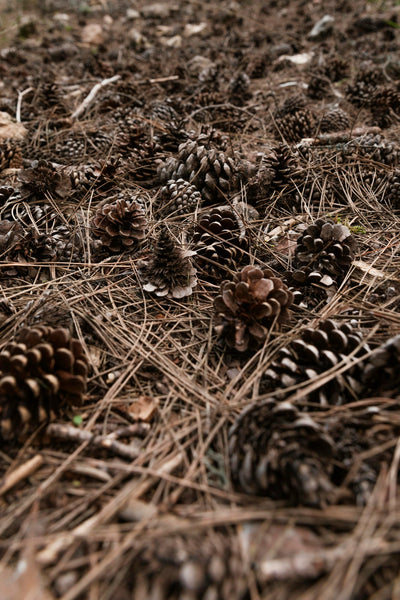Does your dog constantly scratch, lick their paws, or suffer from red, irritated skin? If so, they might be dealing with grass pollen allergies. Just like humans, dogs can develop allergies to various environmental factors, including certain types of grass pollens. In this post, we'll explore the most common grass pollens that affect dogs—Paspalum, Couch, and Kentucky Blue—explain how these allergens can cause reactions, and offer tips on minimizing exposure. Plus, we'll show you how Bags to Bones' dehydrated dog treats can play a role in managing your dog's allergies.
Common Grass Pollens That Affect Dogs
Grass pollens are a major trigger for allergies in dogs. Let’s take a closer look at the most common culprits:
-
Paspalum: This is a common grass type found in warmer climates. Paspalum releases pollen during the warmer months, making it a frequent allergen for dogs who spend time outdoors. Exposure can cause itchy skin, watery eyes, and sneezing in dogs.
-
Couch Grass: Also known as Bermuda grass, Couch is prevalent in many lawns and parks. It’s a hardy grass that thrives in warm conditions, and its pollen can be a significant irritant to dogs, leading to symptoms like red, inflamed skin and frequent scratching.
-
Kentucky Bluegrass: Often used in lawns and sports fields, Kentucky Bluegrass releases pollen that can trigger allergic reactions in sensitive dogs. Symptoms may include itching, hair loss, and skin infections if the dog continues to scratch the affected areas.
How Grass Pollen Allergies Affect Dogs
When dogs come into contact with grass pollens, either through inhalation or skin contact, their immune system may overreact, mistaking the harmless pollen for a threat. This overreaction leads to the release of histamines, which cause the symptoms of an allergic reaction, such as:
- Itchy Skin: Dogs may constantly scratch, bite, or lick their skin to relieve the itchiness, which can lead to sores and infections.
- Red, Irritated Eyes: Grass pollen can cause your dog’s eyes to become red, itchy, and watery.
- Respiratory Issues: Some dogs may develop sneezing or coughing as a reaction to inhaled pollen.
- Ear Infections: Persistent scratching due to allergies can lead to secondary ear infections.
Tips for Minimizing Your Dog’s Exposure to Grass Pollens
While it’s impossible to completely avoid grass pollens, there are several strategies you can use to minimize your dog’s exposure and reduce allergic reactions:
-
Rinse Paws After Walks: After spending time outdoors, rinse your dog’s paws with water to remove any pollen they may have picked up. This simple step can prevent them from bringing allergens into the house.
-
Keep Grass Short: Regularly mow your lawn to keep grass short, reducing the amount of pollen released into the air.
-
Create a Pollen-Free Zone: Consider creating a designated area in your yard with non-allergenic surfaces like gravel or artificial turf where your dog can play without coming into contact with grass pollens.
-
Monitor Pollen Counts: On days when pollen counts are high, limit your dog’s outdoor activities, especially during peak pollen times in the early morning and late afternoon.
-
Use Air Purifiers: Consider using air purifiers in your home to reduce the amount of pollen in the air.
How Bags to Bones Dog Treats Can Help
Managing your dog’s allergies goes beyond just minimizing exposure to allergens. Providing them with a balanced diet that supports their immune system is crucial. Bags to Bones’ dehydrated dog treats are made from all-natural, hypoallergenic ingredients that are gentle on your dog’s digestive system and can help maintain healthy skin and coat. Our Kangaroo and Butternut Pumpkin treats, for example, are rich in essential nutrients that can support your dog’s overall health and help manage skin irritations caused by allergies.
Check out our full range of hypoallergenic, dehydrated dog treats here.
Q & A Section
Q: Can my dog develop a grass pollen allergy over time?
A: Yes, dogs can develop allergies at any age. If your dog starts showing signs of an allergy, such as excessive scratching or red skin, it's important to consult your vet for a proper diagnosis.
Q: How can I tell if my dog is allergic to grass pollen?
A: Common symptoms include itchy skin, red eyes, sneezing, and respiratory issues. A vet can perform tests to confirm if grass pollen is the cause of your dog’s symptoms.
Q: Are there any treatments for grass pollen allergies in dogs?
A: Your vet may recommend antihistamines, special shampoos, or even allergy shots to manage your dog’s symptoms. In some cases, dietary changes may also help.
Q: Why should I choose Bags to Bones dog treats for my allergic dog?
A: Our treats are made with hypoallergenic ingredients that are less likely to trigger allergic reactions. Plus, they’re packed with nutrients that support overall health, including skin and coat health.
Don’t let grass pollen allergies get in the way of your dog’s happiness. Explore our range of all-natural, hypoallergenic dehydrated dog treats here and give your dog the support they need to stay healthy and itch-free. At Bags to Bones, we’re dedicated to providing treats that are as good for your dog as they are delicious.
Grass pollen allergies can be a challenge for both dogs and their owners, but with the right care and preventive measures, you can help your dog lead a comfortable, happy life. Remember, a balanced diet with high-quality treats like those from Bags to Bones can make a significant difference in managing your dog’s allergies. Shop now and see the benefits for yourself!
Bags to Bones is committed to creating high-quality, natural dog treats that promote health and well-being. Our products are crafted with care, using only the finest ingredients to ensure your dog gets the best. Learn more about our story and our dedication to your dog’s health here.













